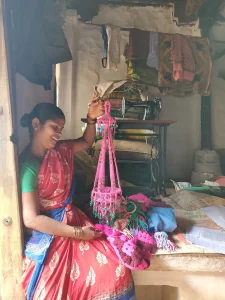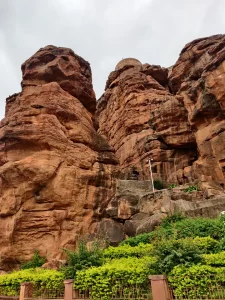It’s been 20 minutes since we arrived in Lokapur village.
We’re silent observers of an important meeting. The Panchayat Development Officer is introducing us to key members of the Lokapur Village Panchayat. He explains that four of us from Good Business Lab are here to conduct field research in a few villages, and scope for new projects to benefit, especially, the women of these villages.
Not too far from this village, we are working with government-sponsored private firm-run rural training centers to understand whether more women will migrate to cities for work if they are trained in the requisite skills and assured of a job. But in the present village, we want to understand whether more women will stay and choose to work if work comes to them in the form of home-based employment.
Encouraging and hopeful, the all-men assembly share their consent for our fieldwork. They see potential in their women, and don’t see why they wouldn’t want to work.
We entered Lokapur in search of women to talk to, preferably in the age group of 18–35 years. And we found quite a few. We spoke to them one by one.
All my teammates spoke Kannada. I spoke only a little. But gestures come in handy for communication — something you realize when your mind is not preoccupied with finding the right words to say. It works the other way too — you can understand so much from observing someone; their body language. While no expert, I felt that the limited comprehension of Kannada, coupled with the intuitive understanding of gestures built over a lifetime of human interactions, was framing a roughly accurate image of the learnings in my mind — something I’d later confirm with the team. I remember thinking that we were being observed too; and there was a strange sense of comfort in knowing that the “fieldwork”, in some way, was mutual.
Through our first day of interviews, we learned that most women in the Lokapur village in the Bagalkot district of Northern Karnataka worked in their family’s agricultural fields and seldom left the village for work. A few had access to sewing machines and had acquired basic skills in stitching, which came in handy to serve the scattered demand for blouses in the village.
We met a lady who taught herself how to stitch by borrowing a relative’s phone and learning on YouTube. She had made many products just to practice her new skills. Her family was supportive and encouraging of her interests, but none knew how the skill could be properly monetized. As she spoke to us, she brought out her creations one after another, from a big bag in which she seemed to have treasured them, hidden from the world. When asked if she would like to sell them, she smiled and said, “why not?”

Women were interested in undertaking paid work outside their households and family farms, at least the majority of those who we spoke to that day. But we were not sure if it was representative of the region. We had to explore more.
With that, we called it a day. We wrapped up the interviews and distributed sweets to the women we met, as a token of our appreciation. Goodbyes take time, as they should. Venkatesh ji, a local who drove us around, was disappointed that he would not be able to show us the famous Badami caves, a feature of the region he is proud of. But hopeful and excited, we told him, tomorrow is another day!

Tomorrow came in 12 hours, and became today.
We started the day by fulfilling Venkatesh ji’s wish and found ourselves surrounded by the magnificent beauty of Badami caves. Rowdy Rathore — a Bollywood film — was shot at this venue, we were informed. Venkatesh ji was clearly a fan!
Fieldwork, especially in rural hinterlands, is rewarding that way. It offers an opportunity to see unexplored landscapes and little-known monuments that tell us as much about the place as its people. A great start to the day, it set the tone for the interviews that followed.
These caves weren’t built overnight, nor were the travails and tribulations of people that we had come here to understand. We needed to be patient, and give people time to open up and share.
With that thought, we reached Adgal.
It was difficult to find women to talk to here. Some were hesitant, some didn’t have the time, some were skeptic, and some just not interested. Aware of our positionality as outsiders, we decided to stay there for some time and make ourselves familiar with the quintessential crowd that hung out at the chai shop. The personal connections we had built in the previous few days over many chais helped, and so did our affinity to mingle with the children. One excited young girl coaxed her mother to interview with us, offering to answer, on her mother’s behalf, the questions the mother hesitated to answer. And so, the interviews started again.
We learned how most women in this village could stitch. Back in 2017, an NGO had provided training in basic stitching for six months to a handful of women. These women went on to become part of self help groups (SHGs) — some even formed their own — and coached many more women. Unfortunately, the lack of employment opportunities in nearby districts discouraged some of them from continuing to use their skill. But their basic skills were still strong.
My interaction with one woman from this village was particularly memorable. I can’t recall the conversation with Kavita ji without feeling goosebumps, for the memory espouses excitement and awe. Kavita ji learnt how to stitch at the age of 16 and started earning by the age of 20, making blouses. Though her husband expected her to help in the fields, she realized and argued that she could contribute more (financially) by staying at home and stitching. She lost her husband at a young age, and tailoring became her only solace. She taught herself to stitch more than just blouses and started selling tote bags, pouches, and slings bags (as popularized by the hit television reality show Big Boss) among others because she saw the potential of a growing market for these products. Today, over 50 years old, Kavita ji has started three SHGs and traveled to more than 15 states across India to sell her products. Her group even made masks and PPE kits during the first wave of COVID-19. Struggling to keep up with the demand, they stitched day and night to fulfill as many orders as they could.
She jovially shared how it only took a small loan to start her business, but the rest just fell in place — the Karnataka State government subsidized the loan, she got linked to trade fairs India-wide through government officials and the friends she made at the fair, and the profits they made enabled them to eventually start lending money to other women. Today, her SHG provides loans to women who want to take the entrepreneurial plunge from the comfort of their village.
Life comes full circle, doesn’t it?

At the end of our interviews with the women of the two villages, we realized that the all-male panchayat we’d spoken to on the first day was not wrong.. On average, women in these villages wanted to work outside of their homes and farms, and if provided the opportunity, they wouldn’t shy away from taking it up, as some of them had demonstrated. However, our interviews revealed a gap in the men’s understanding — of the role they played in making this shared dream a reality. While the men may not necessarily be stopping women from taking up opportunities, they weren’t doing anything to help them either. They seemed to be unaware that for the women in their families to explore their interests, take up paid work, or become entrepreneurs, the men would have to actively contribute in sharing the burden in the household and in the family farms/business.
Not participating in Village Panchayat meetings precludes women from playing a key role in village-level planning and decision making. Representation is important — of women in such meetings and of men in household chores. Becoming passive beneficiaries of others’ decisions, even if noble, doesn’t invigorate the spirit as much as active participation in a process, end to end. After all, empowerment isn’t given, it’s earned.
Women should feel comfortable to express themselves, not necessarily in response to a question, but out of sheer desire, if they so will. And we learnt, through inquiring, that most of them wanted to take up paid work, and earn money. We were happy to know this. It was a good start.
This fieldwork reminded us that staying in touch with the communities we hope to serve is most important. In the sector we work in, solutions evolve, methodologies to understand problems evolve, but often, we forget that the problems on ground evolve too. Investing time and effort in maintaining relationships with the communities enables us to understand the current problems they face so that our proposed solutions aren’t ill-suited, outdated or impractical.
This was the first rural exploratory field work we undertook after the pandemic, and the experience led to a lot of reflection. Though preliminary, our learnings are promising and affirming our interest to work in this space — to understand and address the barriers to women’s participation in the labor force and empowerment in rural areas.
This article was also published on Medium.
Have any questions or thoughts on the article? Write to mansi.k@goodbusinesslab.org